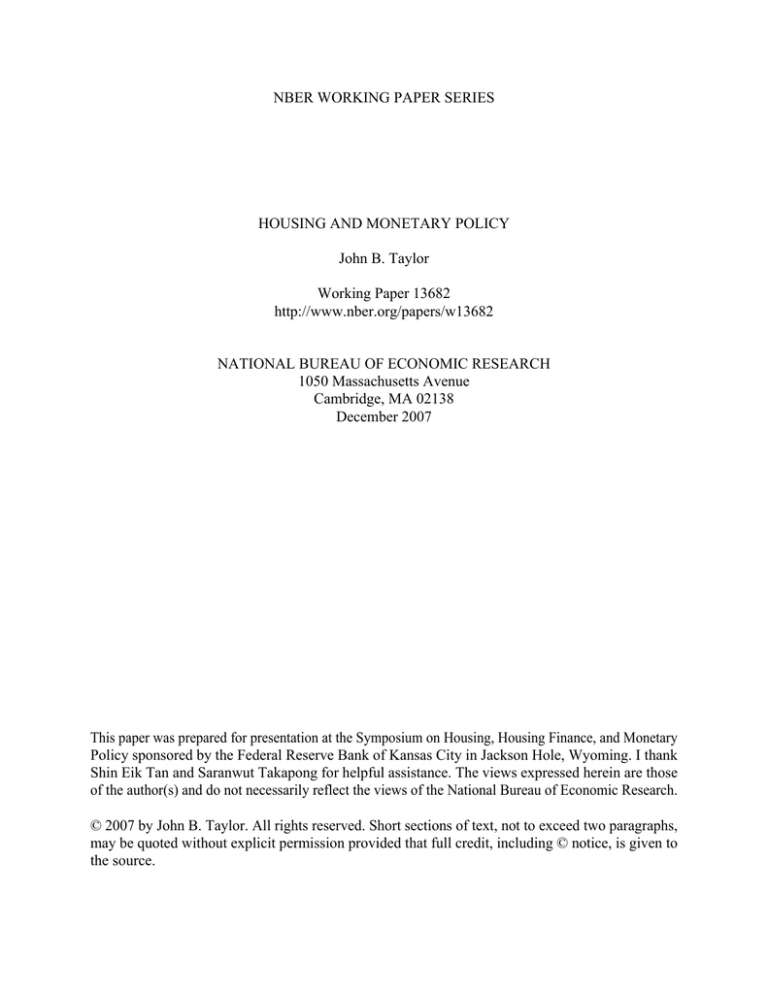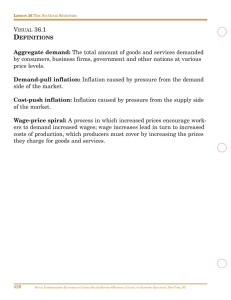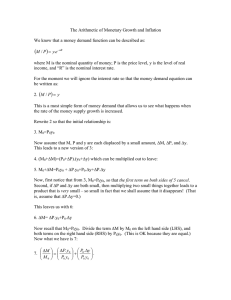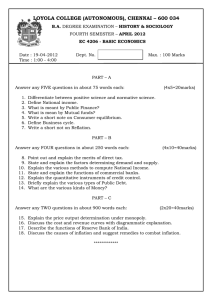
NBER WORKING PAPER SERIES
HOUSING AND MONETARY POLICY
John B. Taylor
Working Paper 13682
http://www.nber.org/papers/w13682
NATIONAL BUREAU OF ECONOMIC RESEARCH
1050 Massachusetts Avenue
Cambridge, MA 02138
December 2007
This paper was prepared for presentation at the Symposium on Housing, Housing Finance, and Monetary
Policy sponsored by the Federal Reserve Bank of Kansas City in Jackson Hole, Wyoming. I thank
Shin Eik Tan and Saranwut Takapong for helpful assistance. The views expressed herein are those
of the author(s) and do not necessarily reflect the views of the National Bureau of Economic Research.
© 2007 by John B. Taylor. All rights reserved. Short sections of text, not to exceed two paragraphs,
may be quoted without explicit permission provided that full credit, including © notice, is given to
the source.
Housing and Monetary Policy
John B. Taylor
NBER Working Paper No. 13682
December 2007
JEL No. E22,E43,E52
ABSTRACT
Since the mid-1980s, monetary policy has contributed to a great moderation of the housing cycle by
responding more proactively to inflation and thereby reducing the boom bust cycle. However, during
the period from 2002 to 2005, the short term interest rate path deviated significantly from what this
two decade experience would suggest is appropriate. A counterfactual simulation with a simple model
of the housing market shows that this deviation may have been a cause of the boom and bust in housing
starts and inflation in the last two years. Moreover, a significant time series correlation between housing
price inflation and delinquency rates suggests that the poor credit assessments on subprime mortgages
may also have been caused by this deviation.
John B. Taylor
Herbert Hoover Memorial Building
Stanford University
Stanford, CA 94305-6010
and NBER
John.Taylor@stanford.edu
This paper focuses on the relationship between monetary policy and the recent turmoil in
the markets for housing, housing finance, and beyond. I begin with a review of the period
leading up to the crisis. I then use this review as a basis for discussing the role of monetary
policy in resolving such crises and preventing future crises.
A Great Moderation of the Housing Cycle
When you look back over the past half century in the United States you see a remarkable
secular change in the housing cycle. Most importantly, the volatility or average size of the
fluctuations in residential construction declined. The change occurred in the early 1980s. For
example, compare two periods, the first before the early 1980s and the second since the 1980s. In
the earlier period the standard deviation of residential investment relative to trend was around 13
percent; in the later period it was 5 percent, and this includes the most recent fluctuation which is
much larger than the average since the early 1980s. Without the current cycle the reduction
would be even larger.
In my view this decline in volatility was largely due to an improved monetary policy, and
it is closely related to the Great Moderation of the volatility of real GDP and inflation which
many researchers have attributed to monetary policy. Compared to the earlier period, monetary
policy has been much more responsive since the early 1980s to changes in inflation and real
GDP. It has also been much more predictable and systematic in its response. This has been
documented using the Taylor rule, where the response coefficient to inflation has increased from
less than one to greater than one and where the response coefficient to real output has also
increased. These higher and more predictable responses have helped tame inflation and have
kept it steadier, thereby reducing the boom-bust cycle and the resulting large swings in interest
rates that had caused the volatile housing.
There are other possible explanations, including the argument that housing became less
impacted by a given change in the federal funds rate due to securitization and deregulation of
deposit rates. However, my estimates of the effect of changes in the federal funds rate on housing
show no evidence of such a shift between these two periods. Moreover, no other explanation that
I am aware of has the timing so precise. Hence, although this subject will be debated for a long
time, I think there is convincing evidence that Federal Reserve policy makers were responsible
for this important improvement.
Recent Developments
However, a careful review of interest rate decisions shows that in some years they did not
correspond so closely to such a policy description. During the period from 2003 to 2006 the
federal funds rate was well below what experience during the previous two decades of good
economic macroeconomic performance—the Great Moderation—would have predicted. Policy
rule guidelines showed this clearly. There have been other periods during the Great Moderation
where the federal funds rate veered off the typical policy rule responses—in particular during the
fall of 1998—but this was the biggest deviation, comparable to the turbulent 1970s.
Many have argued that these low interest rates—or the provision of large amounts of
liquidity that they required—helped foster the extraordinary surge in the demand for housing.
As the Economist recently put it, “By slashing interest rates (by more than the Taylor rule
prescribed) the Fed encouraged a house-price boom….” With low money market rates, housing
finance was very cheap and attractive—especially variable rate mortgages with the teasers that
2
many lenders offered. Housing starts jumped to a 25 year high by the end of 2003 and remained
high until the sharp decline began in early 2006.
The surge in housing demand led to a surge in housing price inflation which had already
been high since the mid 1990s. The housing inflation rate measured by the OFHEO price index
reached 10 percent at an annual rate in the fourth quarter of 2004 and remained over 10 percent
for two years; measured by the Case-Shiller index, housing inflation surpassed 20 percent during
parts of this period. This jump in housing price inflation then accelerated the demand for housing
in an upward spiral. With housing prices rising rapidly, delinquency and foreclosure rates on
sub-prime mortgages also fell, which led to more favorable credit ratings than could ultimately
be sustained. As the short term interest rate returned to normal levels, housing demand rapidly
fell bringing down both construction and housing price inflation. Delinquency and foreclosure
rates then rose sharply, ultimately leading to the meltdown in the subprime market and on all
securities that were derivative from the subprimes.
It is important to address these arguments systematically. There were, of course, good
reasons stated at the time for the prolonged period of low interest rates, most importantly the risk
of deflation following the experience of Japan in the mid 1990s. Nevertheless with the passage
of time we can better understand the ramifications of this policy, and thereby learn lessons for
the future.
A Counterfactual Scenario
The classic methodology for investigating such questions is a “counterfactual scenario.”
What would have happened if an alternative path for the federal funds rate were followed? To
answer this question one needs an economic model that describes how monetary policy—in
3
particular the federal funds rate—affects housing. Ultimately one needs an international
econometric model with endogenous (rational) expectations in which residential investment in
each country is a function of interest rates, including short term and real long term interest rates,
as in the Taylor (1993) multi-country model for example. For the purposes of this policy panel I
took a more straightforward approach. I estimated a simple housing starts equation with the
federal funds rates as the explanatory variable. The equation was estimated with quarterly data
over the nearly 50 year period from the second quarter of 1959 to the second quarter of 2007.
The model shows a strong, statistically significant effect of the federal funds rate on housing
starts which occurs with a lag. The interest rate elasticity is similar to those found in more
complex models such as Topel and Rosen (1988); the semi-elasticity is about -8.3. (The
estimated semi-elasticity was -8.9 in the post 1984.1 period and -8.6 in the pre-1984.1 period.)
I simulated this model under two assumptions: (1) the federal funds rate follows its actual
path and (2) the federal funds rate follows a Taylor rule, smoothed to have the 25 basis point
increment adjustments used by the Fed in recent years. Figure 1 shows the two paths for the
federal funds rate.
4
7
6
5
4
3
2
1
0
2000
2001
2002
2003
2004
2005
2006
Counterfactual Federal Funds Rate
Actual Federal Funds Rate
Figure 1
Observe that the actual and the alternative paths depart in the second quarter of 2002 and
merge again in the third quarter of 2006. I emphasize that this is only one of many ways to carry
out such a counterfactual exercise. Here I use the CPI as the measure of inflation and assume
response coefficients of 1.5 and .5 on inflation and real GDP, respectively. I found that using a
similar, but unsmoothed, path reported by Poole (2007) gives similar results. It would also be
possible to bring the counterfactual path all the way down to one percent and then raise it faster
than the actual path. The most important alterative would be to simulate the counterfactual with
a feedback rule rather than this fixed path in which case the interest rate would not have risen all
the way to 5.25 percent.
Figure 2 shows the results of the simulations using the counterfactual scenario in Figure 1
and compares these with the historical data. The simulations begin in the fourth quarter of 2000;
during the period when the policy is on the rule, the simulation path tracks historical data on
housing starts very closely. When the paths depart one sees how the housing boom continued
5
with the actual interest rates (labeled dynamic simulation), but that there would have been a
much smaller increase in housing starts with the counterfactual simulation of a higher federal
funds rate. Hence, a higher federal funds rate path would have avoided much of the housing
boom, according to this model.
Figure 2
The analysis also suggests that the reversal of the boom and thereby the resulting market
turmoil would not have been as sharp, although the model does not predict as abrupt an end to
the housing boom as in the historical data when the federal funds rate is on the actual path.
However, such sharp falls frequently occur at the end of booms because of rapid changes in
housing inflation expectations. In fact, there is a close interactive relation between housing price
inflation and housing construction (technically, two-way Granger causality). Placing housing
inflation directly into the housing starts equation, and adding a simple equation to explain
6
housing inflation, helps explain more of the decline as shown in Figure 3, but psychological
factors (a Shiller swoosh) still seem to have been at work as the boom ended.
Figure 3
Long Term Interest Rates
A complicating factor in reviewing this period is that long term interest rates did not
increase as much when the federal funds rate rose as would be expected from past experience
during the Great Moderation. A larger increase in long term rates would clearly have mitigated
the housing boom even with the actual path of the funds rate.
7
One of the explanations for this unusual behavior of long term interest rates was that
global saving was very high driving down real long term interest rates. However, while saving
rates were high in some countries during this period, the global saving rate was not. According to
IMF data, global saving was 21 percent of GDP in 2003-2005 compared with 25 percent in early
1970s.
Another explanation for the low long-term interest rates was that they were a direct
consequence of the large deviation from the typical short-run interest rate responses. Long term
interest rates respond to changes in expected future short term rates; if the period of low interest
rates was interpreted as evidence of a change in the response of policy to changes in inflation,
then these interest rate expectations could have declined because of the policy decisions at the
short end of the term structure. Indeed, policy rules estimated during the 2003-2005 period show
a large downward shift in the responsiveness of the federal funds rate to inflation. The
responsiveness appears to be at least as low as in the late 1960s and 1970s. As discussed in
Smith and Taylor (2007), this could have led investors to believe that there was a longer run
change in policy which would have reduced the response of long term interest rates. A key
lesson here is that large deviations from business-as-usual policy rules are difficult for market
participants to deal with and can lead to surprising changes in other responses in the economy.
Delinquency and Foreclosure Rates in the Subprime Market
The extraordinary housing inflation during this period is also closely related to the
problems in the sub-prime mortgage market. While the low interest rates increased the supply of
funds to the mortgage market, there is evidence that the high housing inflation led to a marked
8
reduction in delinquency and foreclosure rates. Figure 4 shows the inverse relationship in the
case of sub-prime adjustable rate mortgages.
Source: Mortgage Bankers Association and OFHEO
Figure 4
Such a relationship is not a new phenomenon as Figure 5 shows. The delinquency rate in
Figure 5 covers all of kinds of mortgages (prime/subprime, fixed and adjustable-rate mortgages).
Regressions controlling for other factors reveal a similar correlation.
9
Figure 5
Observe, however, that as housing inflation began to fall, the relatively low delinquency
and foreclosure rates reversed sharply. But before the reversal many mortgages and mortgage
backed securities were issued with credit ratings that reflected the unusually low delinquency
rates. Only later were the credit ratings reduced. Assessing the risk was particularly difficult
when such mortgages were packaged into securities that combined other types of risk profiles.
Automatic underwriting programs which look at the cross section of a population to calibrate
delinquency and foreclosure probabilities could easily have missed the time series effects of the
change in inflation for newer markets such as subprime adjustable rate mortgages. Hence,
people purchased these securities not knowing the risk that they entailed. Pricing these securities
was difficult with the unusually high inflation rates in the housing markets, but eventually the
risk premiums adjusted to reflect the reality. For example, the Markit ABX Index of securities
10
consisting of subprime mortgages securitized during the second half of 2006 has fallen from
about 82 to 38 since February of this year.
A final and very important part of background for the policy discussion concerns the
spread of the turmoil in the subprime market to other markets. It appears that much of this
spread is based on fundamentals, or the perception of fundamentals, rather than the broader type
of contagion we saw in the 1990s. The indices of option-adjusted spreads of asset-backed
securities and corporate bonds of comparable ratings (either BBB or A) are shown in Figures 6
and 7. The spread between U.S. Treasuries and emerging market debt is shown in Figures 8 and
9. Clearly economic policies in emerging market countries have improved greatly since the
1990s and deserving a great deal of the credit are central bankers.
Lessons Learned
What are the lessons learned from this review? First, stay with the systematic,
predictable, principles-based policy that has worked well for most of the Great Moderation
period. That is, adjust the short term interest rate according to macroeconomic developments in
inflation and real GDP and be wary of adjustments based on other factors.
Second, provide all the funds that banks want to hold at the short end of the market at the
current policy rate. This accommodates fluctuations in the demand for cash and deposits at the
central bank and is fully consistent with the first recommendation of not adjusting the target
interest rate unless the macroeconomic situation changes. This is the open market policy that has
been used recently, especially on August 9 and 10, and that was used to a much greater degree
during the days around 9/11.
11
Following these two principles predictably is the best way to avoid moral hazard and
convince people that there is no “put” in which the central bank is expected to bail out individual
investors. If investors understand and believe that the policy is to adjust interest rates only if
macroeconomic trends change, then they will know that the Fed will do nothing else to help
them out if their own risky investments turn out to be losers. If the current slump in the housing
market, or in the commercial paper market, is causing GDP and/or inflation to fall markedly,
then a cut in the federal funds interest rate would be fully consistent with these principles.
Third, there is more that can be done to make such a policy approach clear. For example,
the Fed could publish its balance sheet on a daily basis, or at least the “Fed balances” that banks
hold at the Fed. That way market participants can determine immediately how much of an
increase in the demand for such balances is being accommodated by the Fed. The information
that is currently posted on the size of repos is not sufficient to figure out the cash demand in the
money markets because of other factors affecting the supply. The information provided about
daily “Fed balances” in the 2001 report on open market operations (Kos (2002), pp. 21-25) is an
example of the usefulness of such data during periods of market turbulence. Publishing daily
data in real time would increase clarity and transparency.
Fourth, there are other direct actions that should be undertaken in the current situation
including insisting on accountability for mortgage originators and improving the supervision of
“off-balance” sheet operations such as conduits. If there are plans for banks to take on some of
the asset backed commercial paper and pull off some of the questionable backing, then this could
be made more transparent as well.
12
Finally, on the international dimension, as I mentioned earlier, emerging market countries
with their large reserves and other improvements in policy have not been affected very much by
the current crisis. Fortunately the IMF has not had to provide funds and we can hope that this
relatively fortunate situation continues. If the situation changes I hope that the IMF adheres to its
new Exceptional Access Framework which provides the same kind of predictability to its lending
decisions as I am arguing has been and is essential for central bank decisions.
13
References
Kos, Dino (2002), “Domestic Open Market Operations During 2001,” Federal Reserve Bank of
New York, February.
Poole, William (2007), “Understanding the Fed,” Federal Reserve Bank of St. Louis, Review,
January/February, Vol. 89. No. 1, pp. 3-14
Topel, Robert and Sherwin Rosen (1988), “Housing Investment in the United States,” Journal of
Political Economy, Vol. 96, No. 4, pp. 718-740
Smith, Josephine M. and John B. Taylor (2007), “The Link between the Long End and the Short
End of Policy Rules and the Yield Curve,” Stanford University
Taylor, John B. (1993), Macroeconomic Policy in a World Economy: From Econometric Design
to Practical Operation, W.W. Norton, New York
14
Option Adjusted Spread of High-Yield Securities
500
450
400
350
300
250
200
150
100
50
0
Jan98
Jul98
Jan99
Jul99
Jan00
Jul00
Jan01
Residential Mortgage
Jul01
Jan02
Jul02
Credit Card
Jan03
Jul03
Auto
Jan04
Jul04
Corporate
Jan05
Jul05
Jan06
Jul06
Jan07
Jul07
Commercial Mortgage
Source: Merrill Lynch
Figure 6
Option Adjusted Spreads of High-Yield Securities
800
700
Basis Point
600
500
400
300
200
100
0
6
1/
6
/0
3
2/
6
/0
6
6
6
6
6
6
6
6
7
7
7
7
7
7
06
06
06
07
07
07
/0
/0
/0
/0
/0
/0
/0
/0
/0
/0
/0
/0
/0
/0
3/
5/
2/
2/
0/
3/
/8
31
28
23
26
21
18
15
30
27
22
25
20
17
3/
1/
2/
3/
/1
/1
3/
4/
6/
5/
7/
8/
9/
12
3/
4/
6/
5/
7/
8/
11
10
Residential Mortgage
Credit Card
Auto
Source: Merrill Lynch
Figure 7
15
Corporate
Commercial Mortgage
/3
11
/0
6
/1
7/
06
12
/1
12 /06
/1
5
12 /06
/2
9/
06
1/
12
/0
7
1/
26
/0
7
2/
9/
07
2/
23
/0
7
3/
9/
07
3/
23
/0
7
4/
6/
07
4/
20
/0
7
5/
4/
07
5/
18
/0
7
6/
1/
07
6/
15
/0
7
6/
29
/0
7
7/
13
/0
7
7/
27
/0
7
8/
10
/0
7
11
Basis Point
Source: JPMorgan
Figure 8
300
EMBI+ Spreads by Region
250
200
150
100
50
0
Africa
Asia
Source: JPMorgan
Figure 9
16
Europe
Latin America







